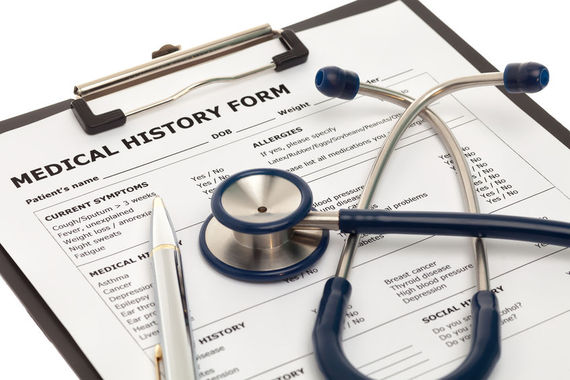Know Your Medical History : Why Is It IMPORTANT
Dec 12, 2015 14:11:01 GMT -4
monalisa and Shilo like this
Post by Admin on Dec 12, 2015 14:11:01 GMT -4

Why is it important to know my family medical history?
A family medical history is a record of health information about a person and his or her close relatives. A complete record includes information from three generations of relatives, including children, brothers and sisters, parents, aunts and uncles, nieces and nephews, grandparents, and cousins.
Families have many factors in common, including their genes, environment, and lifestyle. Together, these factors can give clues to medical conditions that may run in a family. By noticing patterns of disorders among relatives, healthcare professionals can determine whether an individual, other family members, or future generations may be at an increased risk of developing a particular condition.
A family medical history can identify people with a higher-than-usual chance of having common disorders, such as heart disease, high blood pressure, stroke, certain cancers, and diabetes. These complex disorders are influenced by a combination of genetic factors, environmental conditions, and lifestyle choices. A family history also can provide information about the risk of rarer conditions caused by mutations in a single gene, such as cystic fibrosis and sickle cell anemia.
While a family medical history provides information about the risk of specific health concerns, having relatives with a medical condition does not mean that an individual will definitely develop that condition. On the other hand, a person with no family history of a disorder may still be at risk of developing that disorder.
Knowing one’s family medical history allows a person to take steps to reduce his or her risk. For people at an increased risk of certain cancers, healthcare professionals may recommend more frequent screening (such as mammography or colonoscopy) starting at an earlier age. Healthcare providers may also encourage regular checkups or testing for people with a medical condition that runs in their family. Additionally, lifestyle changes such as adopting a healthier diet, getting regular exercise, and quitting smoking help many people lower their chances of developing heart disease and other common illnesses.
The easiest way to get information about family medical history is to talk to relatives about their health. Have they had any medical problems, and when did they occur? A family gathering could be a good time to discuss these issues. Additionally, obtaining medical records and other documents (such as obituaries and death certificates) can help complete a family medical history. It is important to keep this information up-to-date and to share it with a healthcare professional regularly.
For more information about family medical history:
NIHSeniorHealth, a service of the National Institutes of Health, provides information and toolsThis link leads to a site outside Genetics Home Reference. for documenting family health history. Additional information about family historyThis link leads to a site outside Genetics Home Reference. is available from MedlinePlus.
Educational resources related to family health historyThis link leads to a site outside Genetics Home Reference. are available from GeneEd.
The Centers for Disease Control and Prevention’s (CDC) of Public Health Genomics provides information about the importance of family medical historyThis link leads to a site outside Genetics Home Reference.. This resource also includes links to publications, reports, and tools for recording family health information.
The Office of the Surgeon General offers a tool called My Family Health PortraitThis link leads to a site outside Genetics Home Reference. that allows you to enter, print, and update your family health history.
Information about collecting and recording a family medical historyThis link leads to a site outside Genetics Home Reference. is also available from the National Society of Genetic Counselors.
The American Medical Association provides family history toolsThis link leads to a site outside Genetics Home Reference., including questionnaires and forms for collecting medical information.
The National Genetics and Genomics Education Centre of the National Health Service (UK) describes how healthcare providers collect information about a person’s family health historyThis link leads to a site outside Genetics Home Reference..
Links to additional resourcesThis link leads to a site outside Genetics Home Reference. are available from the University of Kansas Medical Center. The Genetic Alliance also offers a list of links to family history resourcesThis link leads to a site outside Genetics Home Reference..
If a genetic disorder runs in my family, what are the chances that my children will have the condition?
When a genetic disorder is diagnosed in a family, family members often want to know the likelihood that they or their children will develop the condition. This can be difficult to predict in some cases because many factors influence a person’s chances of developing a genetic condition. One important factor is how the condition is inherited. For example:
Autosomal dominant inheritance: A person affected by an autosomal dominant disorder has a 50 percent chance of passing the mutated gene to each child. The chance that a child will not inherit the mutated gene is also 50 percent (illustration).
Autosomal recessive inheritance: Two unaffected people who each carry one copy of the mutated gene for an autosomal recessive disorder (carriers) have a 25 percent chance with each pregnancy of having a child affected by the disorder. The chance with each pregnancy of having an unaffected child who is a carrier of the disorder is 50 percent, and the chance that a child will not have the disorder and will not be a carrier is 25 percent (illustration).
X-linked dominant inheritance: The chance of passing on an X-linked dominant condition differs between men and women because men have one X chromosome and one Y chromosome, while women have two X chromosomes. A man passes on his Y chromosome to all of his sons and his X chromosome to all of his daughters. Therefore, the sons of a man with an X-linked dominant disorder will not be affected, but all of his daughters will inherit the condition (illustration). A woman passes on one or the other of her X chromosomes to each child. Therefore, a woman with an X-linked dominant disorder has a 50 percent chance of having an affected daughter or son with each pregnancy (illustration).
X-linked recessive inheritance: Because of the difference in sex chromosomes, the probability of passing on an X-linked recessive disorder also differs between men and women. The sons of a man with an X-linked recessive disorder will not be affected, and his daughters will carry one copy of the mutated gene (illustration). With each pregnancy, a woman who carries an X-linked recessive disorder has a 50 percent chance of having sons who are affected and a 50 percent chance of having daughters who carry one copy of the mutated gene (illustration).
Codominant inheritance: In codominant inheritance, each parent contributes a different version of a particular gene, and both versions influence the resulting genetic trait. The chance of developing a genetic condition with codominant inheritance, and the characteristic features of that condition, depend on which versions of the gene are passed from parents to their child (illustration).
Mitochondrial inheritance: Mitochondria, which are the energy-producing centers inside cells, each contain a small amount of DNA. Disorders with mitochondrial inheritance result from mutations in mitochondrial DNA. Although these disorders can affect both males and females, only females can pass mutations in mitochondrial DNA to their children. A woman with a disorder caused by changes in mitochondrial DNA will pass the mutation to all of her daughters and sons, but the children of a man with such a disorder will not inherit the mutation (illustration).
It is important to note that the chance of passing on a genetic condition applies equally to each pregnancy. For example, if a couple has a child with an autosomal recessive disorder, the chance of having another child with the disorder is still 25 percent (or 1 in 4). Having one child with a disorder does not “protect” future children from inheriting the condition. Conversely, having a child without the condition does not mean that future children will definitely be affected.
Although the chances of inheriting a genetic condition appear straightforward, factors such as a person’s family history and the results of genetic testing can sometimes modify those chances. In addition, some people with a disease-causing mutation never develop any health problems or may experience only mild symptoms of the disorder. If a disease that runs in a family does not have a clear-cut inheritance pattern, predicting the likelihood that a person will develop the condition can be particularly difficult.
Estimating the chance of developing or passing on a genetic disorder can be complex. Genetics professionals can help people understand these chances and help them make informed decisions about their health.
For more information about passing on a genetic disorder in a family:
The National Library of Medicine MedlinePlus web site offers information about the chance of developing a genetic disorder on the basis of its inheritance pattern.
Candy


